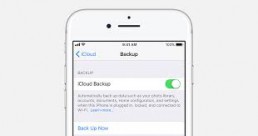If you’re an iPad or iPhone user, you’re probably aware of iCloud Photo. It makes managing photos between multiple devices a breeze. Take a photo on one device and almost by magic it appears on the other.
A fairly recent feature is the optimise iPhone/iPad storage which saves you a lot of “on device” storage if you regularly take photos. If you haven’t switched this on I’d suggest making use of the feature. What it does is store a small “thumbnail” of each photo on your device rather than the full photo. Instead, a copy of the photo is uploaded to the cloud so that it doesn’t take up valuable space. If you click on the thumbnail to view it – the photo is automatically downloaded again. Something to bear in mind though if you don’t have a connection to internet at the time, is you’ll only get a low resolution, blurry version of the picture.
However, I’m not here this time to tell you about all the great features of iCloud Photo – instead this time I’m going warn you about a potentially devastating flaw.
Synchronising between devices is great – it takes the worry out of managing photos between devices, but it’s also something you should be wary of. I had a case recently where different members of the same family each had their own device, but were all signed in with the same Apple ID. This meant that everyone shared the same photo album. Unfortunately, this also meant that a photo deleted from one device would be deleted from all the other devices too. Now iCloud Photo doesn’t immediately, “permanently” delete the photo. Instead, it puts it into a “recently deleted” folder for 30 days. You can go into this folder and restore the photo if you accidentally deleted it, or if you changed your mind. Now unfortunately in this situation, the younger family member decided to free up space on their device by removing all photos, and then deleting them from the recently deleted folder. Yup – years of family photos, deleted from all devices – almost instantly. Devastating.

I tried everything I could to get these photos back. My first thought was that I could restore the photos from a backup. iCloud backup automatically backs up your iPhone/iPad, so I figured I’d restore the photos from there. Nope. If you go into the settings for iCloud Backup – there’s a small warning message at the bottom of the screen that if you’re using iCloud Photo, your photos are no longer backed up in iCloud Backup. The thinking here is that if the photos are already stored in the cloud, there’s no reason to keep another copy of them in a backup.
At this point I called Apple for advice. Unfortunately, they confirmed my fears – the photos were gone and there was no way to recover them.
So what lessons can be learnt from this?
Well firstly, it’s not a good idea to share an Apple ID between different people. Instead, each family member should have their own account. It’s then possible to set up “Family Sharing”. This creates a separate “shared” album for photos. So, each user can have their own photos, but it’s also easy to share photos between family members.
Secondly it pays to have a second backup of photos, instead of relying solely on iCloud. If you have a Windows computer, you can install the iCloud client which will synchronise a copy of all your photos. You can then back up the computer separately to another service or drive. Likewise, if you have a Mac, it’ll have your photos on it and you can then use Time Machine to back it up to another device.
You can never be too paranoid when it comes to backups, especially when it comes to cherished family photos.
Until next time – get those photos backed up!

